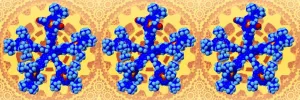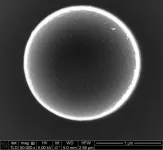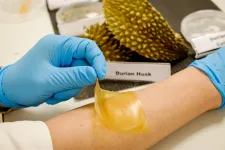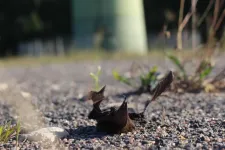Gearing up nanoscale machines
Researchers at Nara Institute of Science and Technology, Japan, in partnership with research teams at University Paul Sabatier, France, are advancing the science of molecular-scale gear trains for transmitting rotational force
2021-03-25
(Press-News.org) Ikoma, Japan - Gear trains have been used for centuries to translate changes in gear rotational speed into changes in rotational force. Cars, drills, and basically anything that has spinning parts use them. Molecular-scale gears are a much more recent invention that could use light or a chemical stimulus to initiate gear rotation. Researchers at Nara Institute of Science and Technology (NAIST), Japan, in partnership with research teams at University Paul Sabatier, France, report in a new study published in Chemical Science a means to visualize snapshots of an ultrasmall gear train - an interconnected chain of gears - at work.
NAIST project leader Professor Gwénaël Rapenne has devoted his career to fabricating molecular-scale mechanical devices, such as wheels and motors. Researchers recently designed a cogwheel for a molecular gear train but currently have no means to visualize the gears in action.
"The most straightforward way to monitor the motion of molecular gears is through static scanning tunneling microscopy images. For these purposes, one of the teeth of the cogwheels must be either sterically or electrochemically distinct from the other teeth," explains Rapenne.
The researchers first created a molecular cogwheel comprising five paddles, where one paddle is a few carbon atoms longer than the other four paddles. However, as they showed last year, differences in paddle length disrupt the coordinated motion along the gear train. Thus, differences in paddle electrochemistry are a more promising design approach but synthetically more challenging.
"We used computational studies to predict whether electron-withdrawing units or metal chemistry could tailor the electronic properties of a paddle, without changing paddle size," says Rapenne. Such tailored properties are important because one can observe them as differences in contrast by using scanning tunneling microscopy, and thereby facilitate static imaging.
"Our pentaporphyrinic cogwheel prototypes contained one paddle with either a cyanophenyl substituent or a zinc - rather than nickel - metal center," explains Rapenne. "Various spectroscopy techniques confirmed the architectures of our syntheses."
How can researchers use these cogwheels? Imagine shining a highly focused beam of light, or applying a chemical stimulus, to one of the gears to initiate a rotation. By so doing, one could rotate a series of cogwheels in a coordinated manner as in a conventional gear train, but on a molecular scale which consists in the ultimate miniaturizatio of devices. "We now have the means to visualize such rotations," notes Rapenne.
By using this development to carry out single-molecule mechanics studies, Rapenne is optimistic that the broad research community will have a powerful new design for integrated nanoscale machines. "We're not there yet, but are working collaboratively to make it happen as soon as possible," he says.
INFORMATION:
Resource
Title: Desymmetrised pentaporphyrinic gears mounted on metallo-organic anchors
Authors: Seifallah Abid, Yohan Gisbert, Mitsuru Kojima, Nathalie Saffon-Merceron, Jérôme Cuny, Claire Kammerer & Gwénaël Rapenne
Journal: Chemical Science
DOI: 10.1039/d0sc06379g
Information about Project Leader Rapenne's lab can be found at the following website: https://mswebs.naist.jp/english/courses/list/labo_13.html
[Attachments] See images for this press release:

ELSE PRESS RELEASES FROM THIS DATE:
2021-03-25
People who are physically active on a regular basis recover better after surgery for colorectal cancer. However, starting to exercise only after the diagnosis is a fact had no effect on recovery, a University of Gothenburg thesis shows.
In working on his thesis, Aron Onerup, who obtained his doctorate in surgery at the University's Sahlgrenska Academy and is now a specialist doctor at Sahlgrenska University Hospital, carried out an observational study of 115 patients diagnosed with colorectal cancer.
The participants who had been physically inactive proved, three weeks after their surgery, to be at higher risk of not feeling that they ...
2021-03-25
Microswimmers are artificial, self-propelled, microscopic particles. They are capable of directional motion in a solution. The Molecular Nanophotonics Group at Leipzig University has developed special particles that are smaller than one-thirtieth of the diameter of a hair. They can change their direction of motion by heating tiny gold particles on their surface and converting this energy into motion. "However, these miniaturised machines cannot take in and learn information like their living counterparts. To achieve this, we control the microswimmers externally so that they learn to navigate in a virtual environment through what is known as reinforcement learning," said Cichos.
With the help of virtual rewards, the microswimmers find their way through the liquid ...
2021-03-25
Food scientists from Nanyang Technological University, Singapore (NTU Singapore) have made an antibacterial gel bandage using the discarded husks of the popular tropical fruit, durian.
Known as the "King of Fruits" in Southeast Asia, the durian has a thick husk with spiky thorns which is discarded, while the sweet flesh surrounding the seeds on the inside is considered a delicacy.
By extracting high-quality cellulose from the durian husks and combining it with glycerol - a waste by-product from the biodiesel and soap industry - NTU scientists created a soft gel, similar to silicon sheets, which can be cut into bandages of various shapes and sizes.
They then added the organic molecules produced from baker's yeast known as natural yeast phenolics, making the bandage deadly ...
2021-03-25
In order to assess the risk of bats dying at wind turbines, it is common practice to record the acoustic activity of bats within the operating range of the rotor blades. For this purpose, ultrasonic detectors are attached to the nacelles of the mast top. In a recent analysis, a team of scientists led by the Leibniz Institute for Zoo and Wildlife Research (Leibniz-IZW) concludes that the effectiveness of this acoustic monitoring is insufficient to reliably predict mortality risk, especially for bats at large turbines. They therefore recommend installing supplementary ultrasonic detectors at other locations on the wind turbines and developing additional techniques such as radar and thermal imaging cameras for monitoring. The results of their analysis are published in ...
2021-03-25
European listed companies in the energy and mining sector provide, to say the least, sparse information on future environmental costs in their annual reports. Researchers believe that stricter guidelines are required as the lack of information may lead to underestimation of environmental liabilities, resulting in that future generations may have to bear the burden of cleanup costs.
"I believe that the future environmental liabilities such as decommissioning costs are often underestimated and few understand the burden these costs might impose on future generations. If, for example, an oil & gas company fails, it costs an incredible amount to clean up after old oil wells and the risk is great that the taxpayers will have to pay the bill. Therefore, it is important that environmental obligations ...
2021-03-25
Increased allergic reactions may be tied to the corticotropin-releasing stress hormone (CRH), suggests a study published this month in the International Journal of Molecular Sciences. These findings may help clarify the mechanism by which CRH induces proliferation of mast cells (MC) - agents involved in the development of allergies in the human nasal cavity.
"In my daily practice, I meet many patients with allergies who say their symptoms worsened due to psychological stress," states lead researcher Mika Yamanaka-Takaichi, a graduate student of the Department of Dermatology, Osaka City University, "This is what led me to do this research."
Together with Professor Daisuke Tsuruta of the same department, they hypothesized that due to its ...
2021-03-25
Bright but disadvantaged students from urban areas are more likely to enter elite UK universities than similar peers from rural communities due to an urban 'escalator effect', according to a new study.
Researchers from the University of Bath analysed data from 800,000 English students commencing university in the years 2008, 2010, 2012, 2014 and 2016.
They found that while in general rural areas had higher overall progression to university than city centres and surrounding areas, when controlling for factors including socio-economic status, age, ethnicity and sex, disadvantaged pupils from rural areas were less likely to progress to one of 27 'top' UK universities.
The authors suggest the difference ...
2021-03-25
NIMS and RIKEN have succeeded in synthesizing the longest ever bottlebrush polymer. This polymer--resembling a green foxtail--is composed of a main chain and numerous side chains grafting from it. The team also succeeded in giving various chemical properties to the ultralong bottlebrush polymer. These achievements are expected to substantially advance the current synthetic methods of bottlebrush polymers. This technique may be applicable to the development of flexible and low-friction polymeric materials.
In the development of polymeric materials, it is necessary to link molecular units with desired chemical properties, called monomers, to ...
2021-03-25
Prof. ZHAO Jin's research team from University of Science and Technology of China (USTC) has made important progress in the development of Spin-Valley exciton dynamics. The research developed an ab initio nonadiabatic molecular dynamics (NAMD) method based on for the spin-resolved exciton dynamics. The team gained the first clear and complete physical picture of valley exciton dynamics in MoS2 from the perspective of first-principles calculations based on GW plus real-time Bethe-Salpeter equation (GW + rtBSE-NAMD).
It can accurately include many-body effects at the level of first principles and break through the bottleneck of GW+BSE method in ...
2021-03-25
When we grow crystals, atoms first group together into small clusters - a process called nucleation. But understanding exactly how such atomic ordering emerges from the chaos of randomly moving atoms has long eluded scientists.
Classical nucleation theory suggests that crystals form one atom at a time, steadily increasing the level of order. Modern studies have also observed a two-step nucleation process, where a temporary, high-energy structure forms first, which then changes into a stable crystal. But according to an international research team co-led by the ...
LAST 30 PRESS RELEASES:
[Press-News.org] Gearing up nanoscale machines
Researchers at Nara Institute of Science and Technology, Japan, in partnership with research teams at University Paul Sabatier, France, are advancing the science of molecular-scale gear trains for transmitting rotational force





